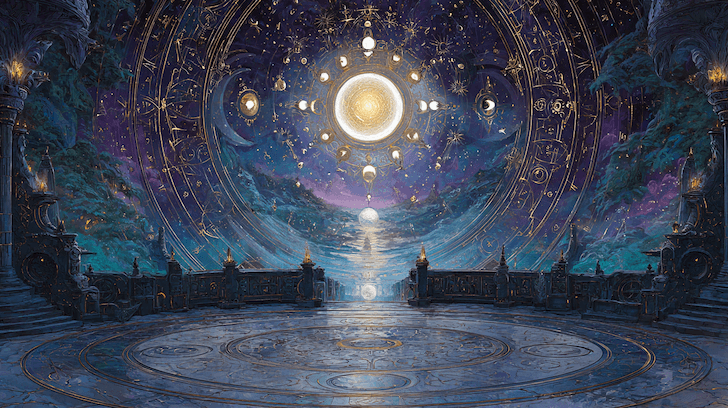What Are Aspects in Astrology?

Aspects are the geometry of astrology—angles between planets and key points that describe how their functions combine and react. They represent the energetic relationships between different parts of a chart, showing where life moves smoothly and where it grinds. A chart’s aspects reveal its structure of harmony, conflict, potential, and integration—how personality traits cooperate, compete, and evolve over time.
When you read aspects, you’re reading how forces within the chart relate to one another. The planets provide what acts; aspects describe how they interact. This is where astrology moves beyond isolated symbols into a dynamic picture of behavior, patterns, and motivation.
Read aspects by which planets are involved, how tight the orb is, and where they land by sign and house. Tight, angular, and luminary contacts speak the loudest.
Major Aspects
The major aspects are the core angular relationships used in every chart. They’re the strongest and most obvious expressions of planetary interaction—forming the backbone of interpretation. These aspects (Conjunction, Opposition, Square, Trine, Sextile) define the most recognizable energies: unity, conflict, balance, ease, and opportunity.
- Nature: Fusion; the functions operate as one.
- Tone: Constructive or difficult depending on planets and signs. Benefics smooth; malefics demand management.
- Use: Describe what the pair does together.
- Mercury–Saturn in the 3rd → careful speech, slow-but-solid learning; risk of self-censorship that becomes mastery with practice.
- Nature: Polarity and balancing across an axis.
- Tone: Awareness through contrast; negotiations with others or between life areas.
- Use: Frame as a seesaw.
- Sun in 10th vs. Moon in 4th → career visibility vs. private needs; healthy expression alternates or integrates across the houses.
- Nature: Dynamic tension; action required.
- Tone: Friction that provokes growth; recurring challenges until addressed.
- Use: Name the practical conflict and the skill it demands.
- Mars square Venus → pacing desire and pleasure; learning assertive diplomacy.
- Nature: Ease and compatible elements.
- Tone: Talents and support; can be underused without intention.
- Use: Identify the gift and its application.
- Jupiter trine Mercury → big-picture thinking supports study, teaching, or publishing.
- Nature: Opportunity that responds to effort.
- Tone: Light, cooperative, teachable.
- Use: Suggest a small action that unlocks it. Moon–Uranus sextile → unconventional routines stabilize mood.
Minor Aspects
Minor aspects are subtler connections that fine-tune a chart’s expression. They often describe refinement, sensitivity, or special skill. While they don’t dominate the overall chart pattern, they can point to specific areas of creativity, restlessness, or growth that major aspects alone can’t explain.
- Nature: Adjustment; mismatched modalities.
- Reading: Two parts of life don’t share a language.
- Build bridges with routines, boundaries, or sequencing. Watch health or stress signals when ignored.
- Nature: Subtle nudge between neighboring signs.
- Reading: Small habits compound; treat like a micro-sextile—low friction, modest payoff if used consistently.
- Nature: Creative problem-solving, craft, stylizing.
- Reading: Where the native makes something special. Emphasize technique and practice, not just talent.
Aspect Orbs
An orb is the distance between two planets from exact aspect. It determines how strongly the aspect operates. A tighter orb means the planets are in closer contact and the influence is clearer; wider orbs act more subtly. Orbs show intensity—how loud or quiet a dialogue is within the chart.
Keep orbs consistent so your interpretation doesn’t drift. Tighten orbs for minor aspects and smaller bodies; allow slightly wider ones for the Sun, Moon, or chart angles.
| Aspect | Typical Orb | Notes |
|---|---|---|
| Conjunction | up to 8° (Sun/Moon up to 10°) | Acts like a merger; sign/house dominate tone |
| Opposition | up to 7° (Luminaries 8–9°) | Axis awareness; watch both ends’ house topics |
| Square | up to 6° | High-activity; tighten to 4° for minor bodies |
| Trine | up to 6° | Ease; may be overlooked without intention |
| Sextile | up to 4° | Opportunity + action; tighter reads cleaner |
| Quincunx | up to 3° | Adjustment; routines/health levers |
| Semisextile | up to 2° | Subtle; habit-level |
| Quintile/Biquintile | up to 2° | Craft/creativity signal |
Triage rule: Rank by (1) orb tightness, (2) angular involvement (1st/4th/7th/10th), (3) luminaries & chart ruler, (4) repetition (themes echoed across aspects).
Applying vs. Separating
An aspect’s motion—whether applying or separating—adds a timing layer to interpretation. Applying aspects describe processes still forming or intensifying; separating aspects describe what has already happened or been integrated. They show momentum and sequence, giving depth to the reading: the approach versus the result.
- Applying: The faster planet is moving toward exact with the slower one.
- In natal work, themes the native is moving into; in timing, indicates incoming developments.
- Separating: The aspect has perfected and is moving apart.
- In natal work, baked-in experiences or skills; in timing, aftermath or results.
- With the same orb, weigh applying more heavily for immediacy.
- An applying square from the ruler of the 2nd to the 10th signals money–career tension addressed through new systems.
Reading the Aspect
- Start simple. Say the aspect out loud — “Mercury square Saturn, 2° applying.” Naming it helps fix what you’re actually working with.
- Look at what each planet does. What are their basic needs or functions? When they connect, do they work together easily or rub against each other?
- Use the houses to ground it. The houses show where the story plays out — communication, work, relationships, home.
- Link the planets’ themes to those areas.
- Sum it up in real terms. Turn the symbolism into a sentence someone could live by — “A drive for achievement meets the need for stability” or “Emotions need structure and consistency.”
- Keep patterns in mind. If similar tensions or supports appear in several places, they reinforce each other.
- The chart always repeats its main themes.
Additional Tips
- Focus on the standouts. Aspects involving the Sun, Moon, Ascendant, or Midheaven shape personality and life direction most strongly.
- Ease and challenge both matter. Harmonious aspects (trines, sextiles) show where energy flows easily; tense ones (squares, oppositions) push growth through effort.
- Patterns tell stories. A T-square, Grand Trine, or Yod ties multiple planets into one repeating theme.
- Read them as a single dynamic, not just isolated angles.
- Stay practical. Ask, “What does this mean for choices, habits, or timing?” Keep your language down to earth and situational.
- Watch timing repeats. When transits echo a natal aspect, that story resurfaces in a new form — same theme, different chapter.
- Keep consistency. Use the same orb rules across the chart so your priorities stay clear and balanced.
Rulerships in Astrology

Stelliums in Astrology

Get Your Birth Chart
Calculate your complete astrological chart with precise astronomical data based on your birth time and location
Generate Chart